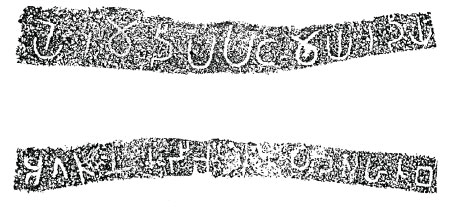
Arahat Mahinda Thera and his missionaries visited Mihintali (Then Missaka Pabbatha) 2,325 years ago on a Poson Full Moon Day.
There are two rock inscriptions referring to the saint Arahat Mahinda; one of these rock inscriptions are at Rajagala in Ampara district and the other at Mihintale.
 The inscriptions from Rajagala with the name of the saint Mahinda stands out as the most important documents as regards religion as well as history. It mentions Mahinda Thera and Ittiya Thera, that latter name being given as Idika. This becomes very important as the information in the chronicle regarding Mahinda Thera’s visit to Sri Lanka is corroborated by contemporary inscription. In the record Mahinda Thera’s and Idika Thera are introduced as Ima-dipa patamaya idiya agatana who came here by the good fortune of this land.
The inscriptions from Rajagala with the name of the saint Mahinda stands out as the most important documents as regards religion as well as history. It mentions Mahinda Thera and Ittiya Thera, that latter name being given as Idika. This becomes very important as the information in the chronicle regarding Mahinda Thera’s visit to Sri Lanka is corroborated by contemporary inscription. In the record Mahinda Thera’s and Idika Thera are introduced as Ima-dipa patamaya idiya agatana who came here by the good fortune of this land.
This refers to the historical anecdote on the immigration regarding the visit here of the missionary party led by the Arahat Mahinda. As the name of the Thera Itthiya is mentioned it goes to prove that the Thera Ittiya, Uttiya, Sombala, Badsala mentioned in the chronicle did actually come here. It must also be mentioned that this record confirms that the ashes of Mahinda Thera were distributed among the viharas of Sri Lanka for entombment in stupa.
The Mahavamsa mentions as follows: “The lord of earth (Uttiya King) has many ceremonies performed during the week and had a pyre built at the Baddhamalaka in the eastern direction.
Taking half the relics the Katriya (King Uttiya) had Thupas built at chetiya Pabbatha and also at all the monasteries. Mahavamsa (chap. xx-42-47). As the script of the record of rock inscription of the Brahmi letters belonged to the second century B.C. it is clear that the stupa at Rajagala was completed not too long after the demise of Arahath Mahinda Maha Thera.
Our attention is drawn to the archaeological evidence of the advent of Arahath Mahinda Maha Thera to our Land.
The rock inscription from Rajagala mentioned with the Brahmi script says, not only the name of Arahath Mahinda Maha Thera Uttiya Thera but also of Arahath Mahinda Maha Thera visiting Sri Lanka. This valuable rock inscription was discovered and interpreted by Prof. Senarat Paranavitana, the former Archaeological Commissioner of Sri Lanka as follows.
“We have already pointed out that contents of these records are Buddhist by early rulers of Ceylon was due to the influence of the Maurya Emperor Asoka. And this is what the chronicle narrated at great length. The agreement of chronicle and our epigraph on this point is emphasized by inscription No. 468 (at Rajagala) making the site of a stupa in which were enshrined the ashes of Arahat Mahinda Thera together with those of UTTIYA THERA. It is well known that Arahat Mahinda
Thera was the missionary who arrived in Ceylon from North India to spread the teaching of the Buddha and Ittiya Thera who accompanied him to Ceylon. Inscription of Ceylon Vol 1 by Prof. Senarat Paranavitana 1970 Dept. of Archaeology II)
The rock inscriptions is Rajagala as follows:
YEIMA DIPA PATHAMYA IDIYA AGATNA IDIKA THERA MAHINDA THERAHA TUBE.
The meaning of this Rajagala rock inscription is as follows:
This is the Stupa of the Elder IDIKA and ELDER Mahinda who came to this land by its foremost good fortune”
The rock inscription at Minintale
The other archaeological evidence of the advent of Arahat Mahinda Thera and those companions to Sri Lanka 3rd Century B.C. is situated at Mihintale.
Statues made of the Theras Mahinda, Ittiya, Uttiya and Baddasala are referred to in inscription of Mahadhatika Mahanaga King (9-21 A.D.) at Mihintale. This is indicated on the right side of the upward climber, beside the steps leading to the upper terrace at the site.
This rock inscription though not contemporary with Mahinda Thera is important as it refers to the making of statues of the above named Theras. This also is an instance of the confirmation of the description of the matter connected with the missionary party of Mahinda Thera mentioned in the chronicle by an inscription of the date close to the event. Basically the advent of Arhath Mahinda Maha Thera and his companions to Sri Lanka is evident by the above two rock inscriptions and the chronicles of our land.
